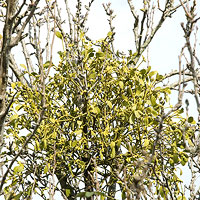Mistletoe
 © Martin Wall
© Martin WallHow It Works
Several constituents have been shown to contribute to the medicinal action of mistletoe. Most notable are mistletoe lectins (also called viscotoxins), choline derivatives, alkaloids, polypeptides, and polysaccharides. Human pharmacological studies have found that mistletoe extract given by injection stimulates immune system function.4, 5, 6 Some test tube and animal studies suggest that certain mistletoe constituents, including the alkaloids, can also kill cancer cells.7, 8 Numerous clinical trials have found that subcutaneous injections of mistletoe extracts can help people with cancer of various organs, though some have also failed to show any benefit.9, 10 There is no evidence that people with cancer would benefit from receiving mistletoe orally.
Mistletoe’s other uses have been less rigorously studied. Preliminary trials carried out using oral mistletoe have found it can reduce the symptoms of high blood pressure, particularly headaches and dizziness.11, 12 However, mistletoe has a small (if any) effect on actually lowering blood pressure.13
Test tube and animal studies suggest that mistletoe extracts can stimulate insulin secretion from pancreas cells and may improve blood sugar levels in people with diabetes.14, 15 Given both mistletoe’s tradition around the world for helping people with diabetes and these promising preclinical results, human clinical trials are needed to establish mistletoe’s potential for this condition.
How to Use It
Traditionally a cold water extract (cold infusion) is made by soaking 2–4 teaspoons (10–20 grams) of chopped mistletoe in two cups (500 ml) of water overnight.16 This is taken first thing in the morning and can be sweetened with honey. Another batch is left to steep during the day and drunk at bedtime. Alternately a hot tea can be made by infusing 1 teaspoon (5 grams) of leaves in a cup (250 ml) of just-boiled water for 5–10 minutes. Two cups (500 ml) are consumed per day.17 A tincture, approximately 1/8 teaspoon (1/2 ml) three times per day, can also be used.
At least three standardized, injectable extracts have been studied in Europe: Iscador, Helixor, and Eurixor. These products are not designed for self-treatment and are not commercially available in the United States. Iscador is the only fermented extract of the three, and each is standardized in a different way, making comparisons between the extracts difficult. In addition, there are different forms of each extract taken from mistletoe growing on different host trees. Typically, one weekly injection providing 1 mg of mistletoe lectin I per kilogram of body weight is given. People interested in subcutaneous or other injectable forms of mistletoe should consult with a physician.
Copyright © 2025 TraceGains, Inc. All rights reserved.
Learn more about TraceGains, the company.
The information presented by TraceGains is for informational purposes only. It is based on scientific studies (human, animal, or in vitro), clinical experience, or traditional usage as cited in each article. The results reported may not necessarily occur in all individuals. Self-treatment is not recommended for life-threatening conditions that require medical treatment under a doctor's care. For many of the conditions discussed, treatment with prescription or over the counter medication is also available. Consult your doctor, practitioner, and/or pharmacist for any health problem and before using any supplements or before making any changes in prescribed medications. Information expires December 2025.










